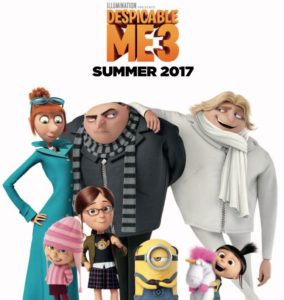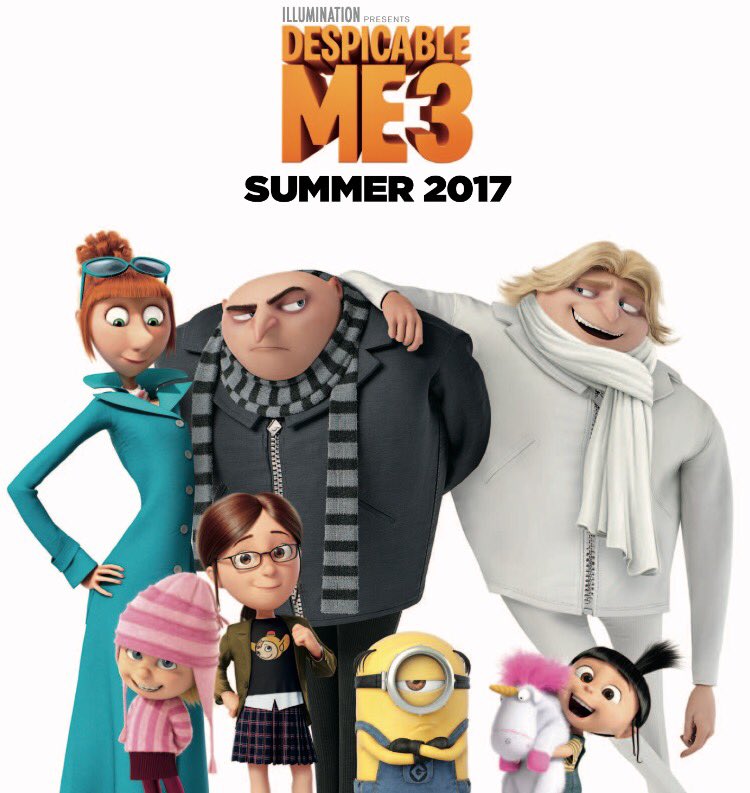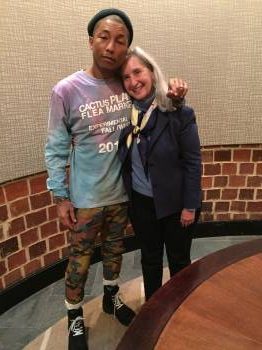Despicable Me 3
Posted on June 29, 2017 at 5:33 pm
B| Lowest Recommended Age: | Kindergarten - 3rd Grade |
| MPAA Rating: | Rated PG for action and rude humor |
| Profanity: | Some schoolyard language |
| Alcohol/ Drugs: | None |
| Violence/ Scariness: | Extended cartoon-style peril and violence |
| Diversity Issues: | None |
| Date Released to Theaters: | June 30, 2017 |
| Date Released to DVD: | December 4, 2017 |

The problem with making the title character into a happily married good guy who loooves his three girls is that he is not despicable any more. He is therefore much less interesting than the actually despicable villain of the movie, Balthazar Bratt (Trey Parker, co-creator of “South Park”), an 80’s child star embittered because he has been forgotten. Whenever Bratt is not on screen, the film deflates. It is a cute, fun, and sweet-natured family treat, but overstuffed at just 90 minutes with too many distracting detours.
Formerly despicable Gru (Steve Carell) is now working with Lucy (Kristen Wiig) at the AVL (Anti-Villain League), and Lucy is also trying to learn how to be a mother to the three girls, serious middle-schooler Margo (Miranda Cosgrove), mischievous Edith (Dana Gaier), and sweet, unicorn-loving Agnes (Nev Scharrel).
Gru and Lucy stop Bratt from stealing the world’s largest diamond, but he gets away, and the new, very ambitious, head of the AVL (Jenny Slate) fires Gru. Lucy quits in protest. As they begin to think about finding new jobs and Agnes sells off her beloved fluffy stuffed unicorn to help out, Gru finds out for the first time that he has an identical twin brother. “Parent Trap” style, when their parents split up, they split the babies up, too. An emissary from Gru’s brother, Dru (also Carell) invites them for a visit to Freedonia, presumably the country responsible for their accents and certainly the country where the Marx Brothers created memorable mayhem in “Duck Soup.”
Dru is identical to Gru except for luxuriant blond hair. And it turns out he wants to be despicable, like their late dear old dad. The brothers go for a wild joyride in Dad’s crookmobile. Bratt has now successfully stolen the world’s biggest diamond, and so Gru tells Dru they will steal it from him. Dru thinks they will keep it, but Gru plans to return it so he and Lucy can get their jobs back.
Meanwhile, the minions are performing Gilbert & Sullivan on a TV reality show and being thrown in prison. Lucy is still not sure how to connect to the girls. Agnes thinks she can find a unicorn. And Bratt is getting ready for the ultimate revenge on the Hollywood that rejected him.
The film flags whenever Bratt is off-screen. He is an inspired creation, with lots of 80’s references for the parents and just the right touch of whiny entitlement to seem quite timely. He just about makes up for the slow patches. The snatches of the terrific Pharrell Williams score from the first film serve as a reminder that this, too, is mostly just an inferior copy, we hope, the last.
Parents should know that this film includes cartoon-style peril and violence, mostly comic, crotch hit, some potty humor, and brief minion nudity.
Family discussion: Why didn’t Lucy know when to say no? What made Margo trust her? Why did Gru’s parents tell their sons they were disappointments?
If you like this, try: the other “Despicable Me” movies and “Megamind”



